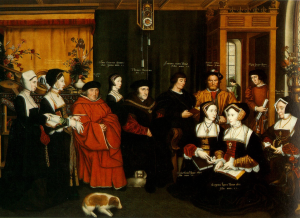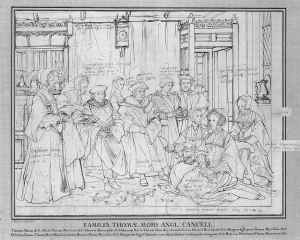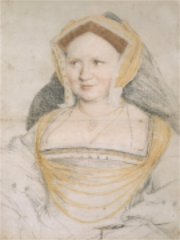The Gown: Exploring the Evidence
The Gown: Discussion and Evidence
Bodice/Neckline
The bodice is smooth in front and shows no signs of a seam in the front, or lacing, although each seems most likely to have been present. The smoothness can be accomplished by a placard placed over the lacing (see Mikhaila and Malcolm-Davies, 2006, The Tudor Tailor, pg 111ff 'Fashionable Henrician lady: French Gown' for an example of this).
The neckline across the bust curves up slightly and is quite wide, the corner going quite close to the underarm area. The gown fits just below the kirtle, which is snug against the skin. The neckline goes up over the shoulders at an angle. The portrait and drawing of Mary Wotton do not show what is happening in the back of the gown. For that we have to turn to the sketch by Holbein, dated to the same period of time as the portrait.
Back
Assuming the back of the gown is much like the one pictured in the sketch at right 'Woman: Two Views' by Holbein, then the neckline of the gown comes over the shoulders at an angle and makes a blunt nosed triangle between or just below the shoulder blades. As an aside, it seems the smock and kirtle do this too, as to follow the edge of the gown neckline closely.
The gown is gathered at the back, but not around the sides or front. The pleats fall from the back waistline down to a skirt with a slight train.
Once again, the pattern mentioned above in The Tudor Tailor, 'the Fashionable Henrician Lady', follows this example fairly closely, and will be used to model the back of the gown I will make.
Waist
The gown is waisted. The waist dips in the front (it is not straight across the waist line) or at least it seems to. The pattern in The Tudor Tailor follows this idea. There are no gathers of the skirt at the front waist, and the skirt is shaped to fall gracefully to the floor; see 'Woman: Two Views', by Holbein.
Front Closure
As mentioned above, it is likely the gown was front closing and laced over the bodice. A placard then provided a smooth frontage and covered the lacing. Below the waist line the dress was open for a few inches (perhaps 8 to 10?) and then closed down the front of the skirt. The front skirt closure is contra the pattern in The Tudor Tailor mentioned above, but is supported by various portraits and sketches, including the 'Woman: Two Views', sketch by Holbein.
As further evidence we have the sketch done by Holbein of the Thomas More family, and the copy of the painting done in the late 1500s.


From Wikipedia. Note the change in personnel between the sketch and the painting.
Many of the women in the painting, More's daughters and daughter-in-law, are pregnant. They are not wearing the placard across front of the gown, and their gowns are laced only lightly over their bodice. The gown opening gapes over their pregnant tummys and then is sewn together below that. The kirtles, visible through the gaps in the lacing and the bottom waist of the gown on the women, all tend to match their sleeves in the painting.
Skirt Length/Style
Mary's portrait is not full length so the style of the skirt of her gown is unknown. However, the full-length sketch shows a trained gown, smooth in the front and gathered in the back. I will construct my gown in this manner.
Sleeves
Sketches and Portraits
If you click on them, you'll be taken to a much larger version, in most cases.
Images from Wikimedia Commons.
Image from the British Museum Collection



